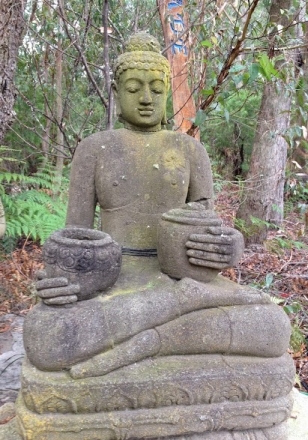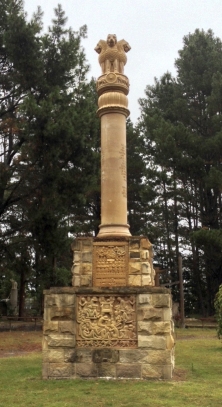Mahayana Buddhism and Theravada Buddhism
Preface
Buddha’s Life and early teaching gives the background to the development of Buddhism. As we cover the first few centuries after the death of the Buddha, we will encounter lot of words ending in "a". Don’t be put off by these words or try too hard to learn them. While we need to use the correct terms, and this will give you a brief history, many practising Buddhists today have little or no understanding of this evolution. And it’s really not that important in being a Buddhist other that from a historical point of view.
The Two Schools.
In most major religious philosophies, you will find many groups who interpret the core teachings in their own style. In Christianity, there was the major split between the Catholics and Protestants, and again within Protestant groups, there are other groups such as Seventh Day Adventist, Mormons as well as the more orthodox Anglicans.
So it is with Buddhism.
During the Buddha’s life, no written records were made of his teaching, as it was passed on by oral methods; monks learned fixed passages of what had been spoken. The Buddha also never set up any infrastructure or proposed high rank for himself. He denied any divinity and emphasised that all people are equal.
Obviously, there was a need to continue the teaching after he died, and five hundred of the more senior monks met at a council to decide how this would happen. The council lasted seven months, and this determined how the teaching would continue.
From about 100 years after the death of the Buddha, there had been a movement towards a more embracing style of Buddhism. The early monks concentrated on personal enlightenment, seeking the spiritual answers for themselves, and teaching others the way to this enlightenment. But the information was severely limited to the lay community as it was assumed only monks could achieve Buddhahood.
Mahayana Develops:
Over the next three hundred years, a group evolved who believed that compassion for all humanity was an important part of the path, and that the teaching be fully available to all.
Those who followed the new expanded ideals called themselves Mahayana, meaning the Big Raft, and referred to those who stayed along traditional teaching as the Hinayana group, meaning small or lesser raft. In other words, the implication was that the Mahayana approach was available to more people.
The original group did not like the term Hinayana, and then referred to themselves as Theravada, the way of the Elders.
The concept of a Yana, the raft came from the Buddha. He lived in a land which was crossed by many rivers and canals, and the way across was mostly by ferry or raft. So he described the spiritual journey as one that needed a raft, a philosophy that could take you another step on the way to enlightenment. He said "my teaching is like a raft which can help you cross to the other shore beyond birth and death. Use the raft to cross to the other shore, but don’t hang onto it as your property. Do not become caught in the teaching. You must let it go."
This was taken by the Mahayanists to tell them that the old style could be let go as long as the core teaching remained.
With the move to Mahayana Buddhism, it became more like a religion than the original Theravada Buddhism.
Buddhism based on the Theravada model is found today in Sri Lanka, Burma, Thailand and Cambodia, while the Mayahana style went north into China and from there Japan, Tibet and Korea. The Theravada group has remained a fairly unified one, but the Mahayana group again divided into several strands, including Zen and Tantric Buddhism.
Differences:
The main differences between Theravada Buddhism and Mahayana
Buddhism are shown in this table (which includes some details from the book
"The World's
Religions" by Huston Smith
![]() ):
):
| Theravada | Mahayana |
| Individual effort leads to enlightenment | Working towards enlightenment |
| For the self only | Should also include all living beings |
| Strives for wisdom first | Compassion is the highest virtue |
| Centres on meditation, and requires personal dedication such as being a monk or nun | Encourages practice in the world and among the general community |
| Followed as a teaching or Philosophy | Followed with reference to higher beings, more like a religion |
| Early work written in Pali (eg kamma, dhamma) | Early texts are in Sanskrit (eg karma, dharma) |
Another significant difference is in the emphasis on the Bodhisattva, or spiritual guide. The Buddha referred to the concept of Bodhisattvas before his death, but it was not crucial to the original Buddhists. With the development of the Mahayana Buddhism, the Bodhisattvas became a significant part of the new thinking.
 Bodhisattva means "enlightened being" and the ideal of the Bodhisattva is
that of one who has reached ultimate understanding, and delays
final enlightenment to help others make spiritual progress.
Bodhisattvas are shown as having no need to hurry in a state of
serenity.
Bodhisattva means "enlightened being" and the ideal of the Bodhisattva is
that of one who has reached ultimate understanding, and delays
final enlightenment to help others make spiritual progress.
Bodhisattvas are shown as having no need to hurry in a state of
serenity.
In Mahayana Buddhism, all practising Buddhists are apprentice Bodhisattvas. Along the way, the various sects introduced a range of high level Bodhisattva figures, who represent different values to be sought, such as wisdom and compassion, and who may provide protection to those who pray to that particular Bodhisattva.
This is not dissimilar to the Saints of the Christian Churches.
The early Theravada philosophy, in particular, strongly emphasised reason and analysis, along with direct personal experience. The Mahayanists saw this as narrow and limited, and sought to engage the emotions as well. Meditation now could also include visualising enlightened beings such as Bodhisattvas, and these were now objects of devotion.
One of the most popular of the bodhisattvas is Padmapani, meaning bearer of the lotus (padma). He is the compassionate one and will appear in different forms to teach people the way of enlightenment. Padmapani became Avalokitesvara who is popular in Tibet and the female Guanyin well loved in China.
Technically, the Theravadas do not not worship the Buddha, but will honour his memory, for example by walking in a clockwise direction around a dome called a stupa. Sometimes the stupa holds a relic of the Buddha, which is more revered. In Mahayana countries, images of the Buddha are set up in temples and homes as an object of worship. Of course, this is a generalisation and variations of devotion occur in all Buddhist countries.
Because of the Buddha’s open approach to all religious philosophies, and his tolerance of all genuine seekers, the Theravada and Mahayana groups have no history of major conflict, and, in the early days, often shared the same monastery with each other.

Emperor Ashoka:
The Emperor Ashoka was a warrior king who ruled over most of the Indian sub-continent from 273BC to 232BC. After a particularly vicious victory in battle, Ashoka took on and promoted Buddhism, and he funded its growth around many parts of India. In conjunction with the council, he also sent missionaries to regions outside India, beginning the spread of Buddhism around the world. He supported an early form of the Theravada school of Buddhism, and one of his sons (Mahinda) spread the Theravada form of Buddhist teaching to Sri Lanka. However, after the death of Ashoka, the Mahayana school became the more popular form of Buddhism in India.
Rise of Mahayana:
The Mahayana tradition developed gradually from about the 1st Century BC, and mostly co-existed harmoniously with the early Theravada schools, often sharing the same premises. Mahayana was more encompassing, and active in breaking down the caste barriers, so as to include everyone, and over time, developed into many schools of Buddhism that are popular today.
Another reason given for the spread of the Mahayana group was that they were more flexible and able to interpret the teaching more liberally. In particular, the early Theravadas read in the scriptures that they should wear cotton robes, which are much too light for the colder climates of China. The Mahayana monks chose wool and felt robes and happily went north.
Today, both versions of the original teaching are studied to determine the consistency of the original teaching, which is remarkably similar in many areas.